Practicing 13 sketchbook eyes lets artists explore all sorts of wild and expressive gazes. They can try big, shiny “puppy dog” eyes, sharp and angry glares that look like trouble, and tired droopy peepers that say, “I need sleep now.” Eyebrows and eyelids change everything, while different pupil shapes, wild highlights, and bold shadows crank up the mood. Even sneaky or surprised looks can pop off the page. There are secrets to every stare—keep going to reveal them.
Key Takeaways
- Practice drawing big, round eyes with curved outlines and highlights to develop friendly, playful gazes.
- Experiment with sharp, angular eyes and dramatic shadows to capture intense and angry expressions.
- Sketch droopy eyelids, dark circles, and gentle brows for tired, sad, or vulnerable eye expressions.
- Create wide, round eyes with large pupils and arched eyebrows to convey surprise or shock.
- Use emotional shading, varied pupil shapes, and unique highlights to add depth and individuality to expressive eyes.
Practicing Round Friendly Eyes
Sometimes, all it takes is a pair of big, round eyes to make a character look like the friendliest face in your sketchbook. If you want to make your characters burst with warmth, try practicing expressive eyes with smooth, curved outlines and oversized shapes.
The bigger and rounder the eyes, the more open and innocent your character seems! Add in some highlights—maybe even a tiny star-shaped one—and watch those eyes sparkle with personality.
Play around with different pupil sizes and positions: wide pupils scream with excitement, and raised pupils can shout “pure joy!” Don’t forget the eyelids. Thin or thick lines on top can totally change the vibe, so experiment until everything looks just right.
Friendly eyes, big smiles—magic!
Drawing Angular and Intense Eyes

Not every character has to look sweet or bubbly—sometimes the story calls for a pair of eyes that mean serious business. When it’s time to make those eyes open wide with intensity, grab a new layer and let’s draw some seriously angular eyes.
Sharp corners and stretched shapes can transform a stare into something fierce—think heroes in deep battle mode or villains up to no good. Lowered eyebrows help the mood, making your character look extra focused (or a bit mad).
If you want to go even bolder, try slitted or really narrow pupils for that “don’t mess with me” vibe. Don’t forget to add sharp-edged highlights and tweak the eyelids, because every angle can crank up the drama in your sketchbook!
Experimenting With Droopy Tired Eyes
When energy levels drop and the eyelids start to droop, sketchbook characters can look downright exhausted—and that can make for an eye expression loaded with drama.
Droopy tired eyes are all about lowered eyelids, with the outer corners curving slightly upward, almost as if the eyes are begging for a nap. To capture this sluggish vibe, try drawing one layer of subtle shadows underneath, plus soft lines for those classic dark circles.
Eyebrows should be relaxed, not super high or tense, and just a little arched—perfect for showing a character is too tired to care.
Sometimes, dropping the pupils lower in the eye, and even narrowing the eyes just a bit, really sells the tired, “wake me up later” look.
Exploring Wide Surprised Eyes
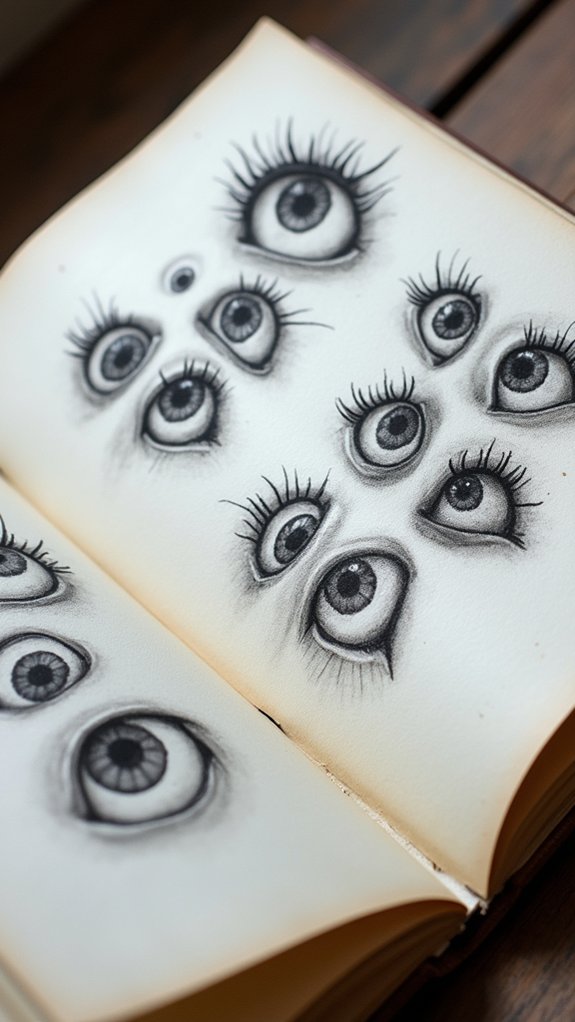
Wide surprised eyes are like little spotlights, grabbing everyone’s attention and shouting, “Whoa, what just happened?” In sketching, these eyes really stand out with their round shapes, huge pupils, and eyelids that seem to jump right up the forehead.
Wide eyed wonder is all about capturing that moment when someone is suddenly filled with innocent surprise or a totally shocked expression. The pupils look bigger, the irises get brighter, and—if you add those star-shaped highlights—the wow-factor just explodes.
Don’t forget those arched eyebrows, shooting up like rocket ships to sell the emotion. Playing around with different shapes and highlights lets each gaze look unique—and maybe even adorable. These eyes can turn any character into a bundle of instant, heartfelt energy.
- Fills the page with contagious excitement
- Makes viewers smile with pure innocence
- Tells a silent story with just one glance
Creating Narrow Suspicious Gazes
Suspicion is like a cat creeping along a fence, eyes narrowed and every muscle coiled to pounce.
When drawing a narrow suspicious gaze, artists use some clever suspicious gaze techniques. First, eyebrow positioning does a lot of heavy lifting—pulling those brows lower, almost daring someone to try and fool them.
Next up, eye shape variations matter a ton. Instead of big round eyes, go for angular, slanted shapes, and shrink the upper eyelid just a bit. This says, “I’m onto you!” without a word.
Keeping the lower lid steady and pupils slightly contracted adds even more alertness. Sometimes, drawing the eyes closer together cranks up the intensity, like a detective zeroing in on clues, or a teacher spotting a cheater!
Shaping Slitted Sinister Pupils
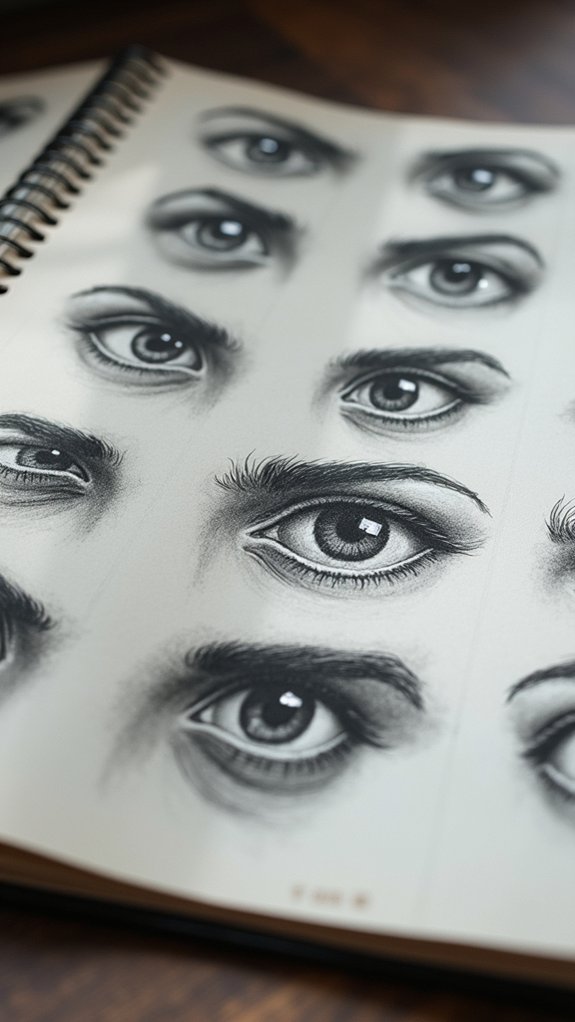
Eyebrows aren’t the only part of a suspicious stare that can spook someone—sometimes, it’s all in the pupils. Slitted pupils, often seen in creepy cats or slithering snakes, are perfect for creating sinister expressions that pack a punch.
Playing with pupil size can really ramp up gaze intensity: narrow slits might look sneaky, while wider slits seem more shocked or fiendish. Even the smallest change—a highlight here, an angle there—totally transforms the vibe. Cartoon villains and mysterious beasts just feel more alive and eerie with these little details.
Need some inspiration? Real animals with wild eyes are great to observe!
- Imagine the shiver you get meeting a sharp-eyed villain in a dark forest.
- Picture a gaze that chills you to your core.
- Think of the villain’s secret, always hidden, lurking behind those eyes.
Designing Upturned Playful Eyes
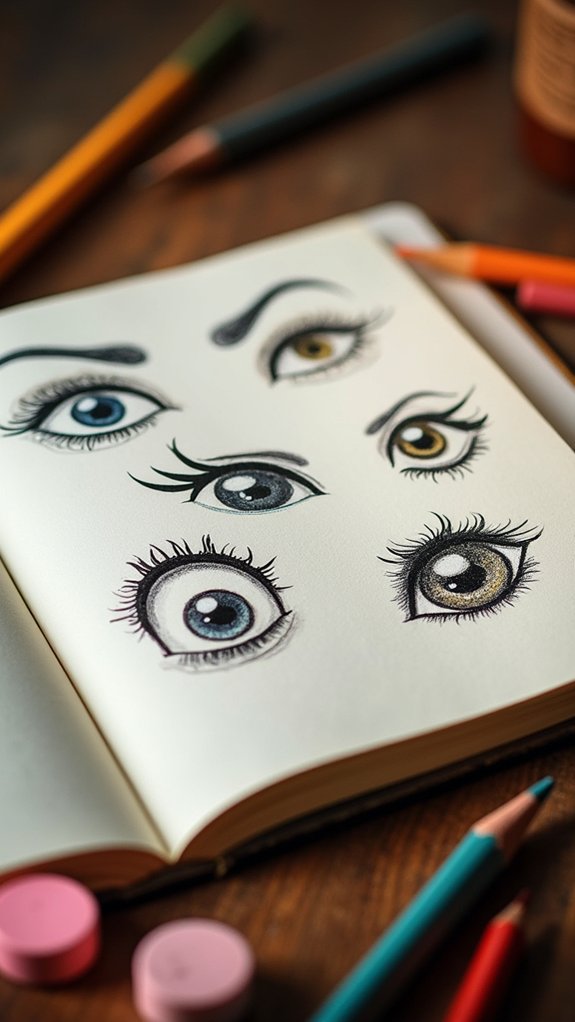
Even if most people don’t know the technical name, they recognize that upturned eyes can totally change how a character feels.
Something about that gentle curve in the upper eyelid and the way the outer corners sweep upward just screams playful expressions. Suddenly, a face looks like it’s always thinking of a joke—or maybe they’re about to start a pillow fight.
Artists can play with eye shape variations by tilting the inner corners of the eyes just a bit. That tiny change makes eyes look way more joyful or curious.
For even more lively reflections, add larger pupils and sprinkle in some vibrant highlights. Using lighter colors around the outer edges brings the eyes to life, making them shine with energy and fun.
Adding Star-Shaped Highlights for Cuteness
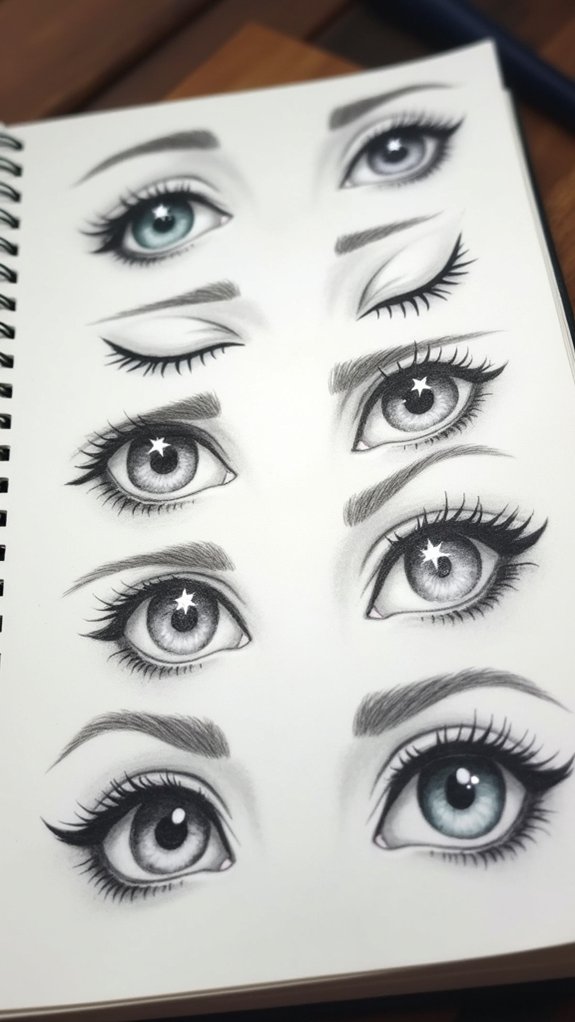
After playing around with those upturned, playful eyes, it’s hard not to wonder what else could make them stand out—maybe something with a little extra sparkle.
That’s where adding star-shaped highlights comes in. Just imagine star highlight placement that shines right in a character’s eyes, giving them instant cuteness points. Stars, instead of ordinary dots, can turn a drawing from simply adorable to “I must protect this character” level.
Plus, playing with the size and position of the stars changes how viewers feel—smaller stars might look gentle, while bigger ones seem super playful. It’s also a fun way to boost character uniqueness among a sea of lookalikes.
- That first sparkle hint of secret mischief
- A big, shimmering “aww!” moment
- Unmistakably unique, with eyes nobody could forget
Illustrating Downturned Sad Eyes
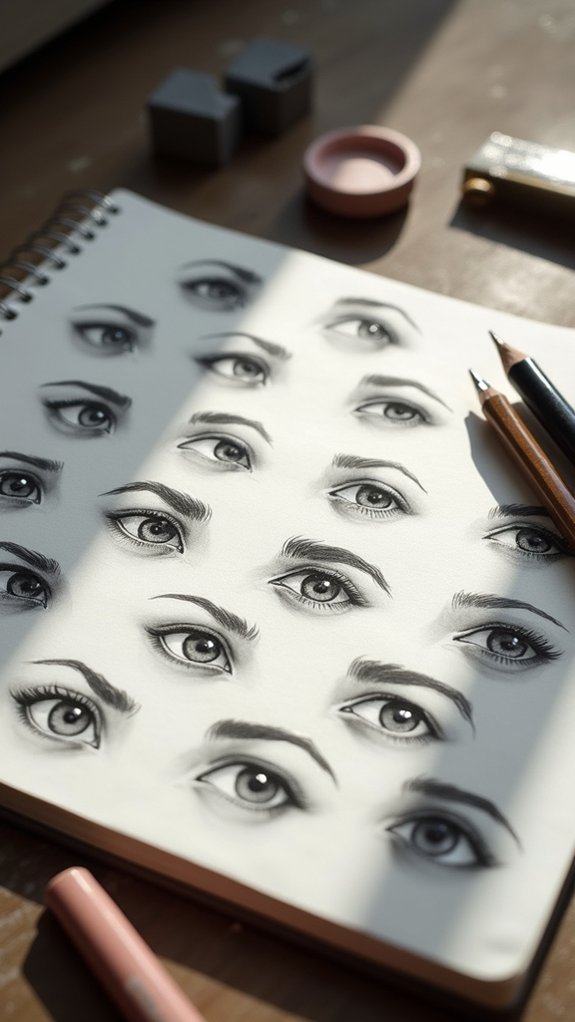
When sketching downturned sad eyes, getting that gentle curve of the eyelids just right makes all the difference—and don’t forget the outer corner dips, like the eyes are literally weighed down.
A little extra shading or detail near the tear duct can really push the feeling, as if tears are just about to spill (we’ve all been there, right?).
The eyebrows shouldn’t look surprised or angry; lower them softly, almost as if the whole face feels heavy, and you’ll set the perfect stage for sad expressions.
Downturned Eyelid Curvature
Although drawing sad eyes might sound a bit gloomy, there’s actually something really powerful about getting that downturned eyelid just right.
Downturned eyelid techniques involve a careful curve; the eyelid gently slopes down, making the outer corner lower than the inner. This subtle shift instantly signals sorrow or emotional heaviness.
Through emotional expression exploration, artists discover how even small changes can share a character’s story—sadness, weariness, or quiet reflection. Drooping eyelids help too, hinting at fatigue and making the expression even more convincing.
Subtle highlight application on the eyes catches light, adding a glimmer that contrasts with the downcast look and makes it feel more real.
- Viewers feel empathy for the character’s struggle
- The artwork invites reflection on difficult emotions
- Gentle shapes soften the emotion but don’t hide its depth
Tear Duct Emphasis
A sketchbook page might look ordinary at first, but all it takes is a strong tear duct to turn a regular set of eyes into a real heart-tugger.
Tear duct techniques can transform a basic gaze into something packed with feeling. When drawing downturned sad eyes, artists often let the lower eyelids droop, adding slight lines underneath, like a hidden story of tears. If the inner corners curve up a bit, it cranks up the vulnerability—like the eyes are quietly asking for a hug.
Emotional shading is the secret weapon here; softening around the tear duct brings out a tender edge, while adding larger, darker pupils boosts the eye expression with an extra dose of longing.
Drama? Absolutely. And it’s all in the details.
Gentle Lower Eyebrows
Sadness has a way of showing up right on the eyebrows—even before the eyes get watery.
When sketching eyes that look truly sad, gentle brow shaping is key. Lower the brows, tilt them down and give them a slight furrow. This small detail packs a punch: it screams, “I’m feeling blue!”
The eyes themselves can be a bit droopy, matching the softened position of the brows. Use soft highlight techniques—try faint highlights along the lower lids or in the corners to bring out the delicate mood.
For strong emotional eye alignment, make sure the brows, eyes, and mouth all agree on that sorrow.
- Softly arched brows tell a quiet, lonely story
- Gentle highlights show a glimmer of hope
- Downturned gaze brings fragile vulnerability
Exaggerating Angry Eyes With Contracted Pupils
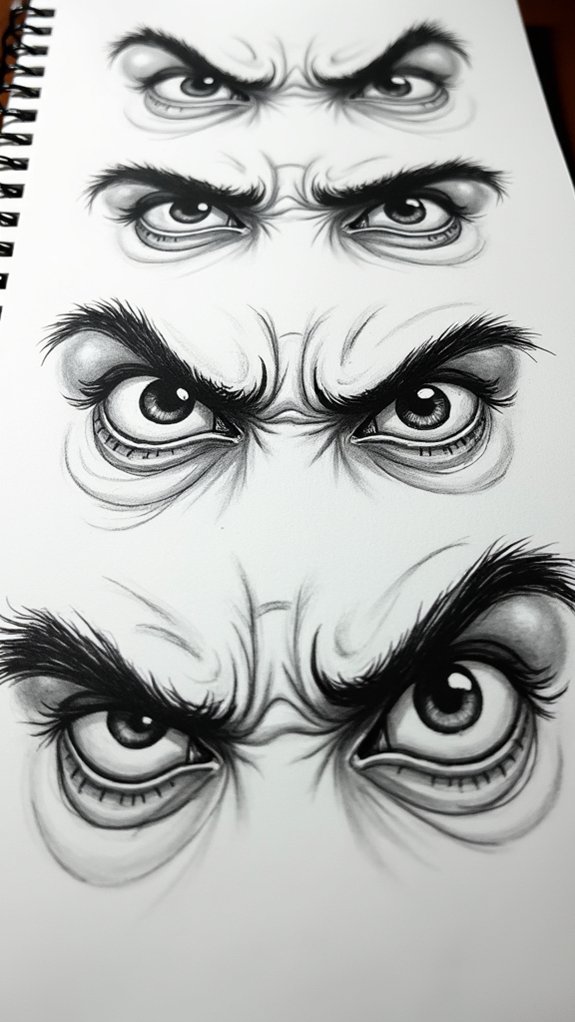
There’s real magic in making a character look seriously mad—like, you just ate the last cookie and now they’re plotting dramatic revenge.
When using angry expression techniques, contracted pupils can do wonders. They crank up the emotional intensity and instantly show that your character’s got a laser focus—on you, probably.
Eye shape variations matter too. Go for sharp, angular lines instead of soft, round shapes to make the eyes scream hostility.
Dropping the brow lines low is an old-school trick, giving those epic furrows above the eyes. That adds a powerhouse vibe of rage and frustration.
Plus, tossing in dramatic shadows or bold highlights amps up the tension even more. With every detail, the eyes become the center of a seriously intense expression.
Blending Eyebrow and Eyelid Movements
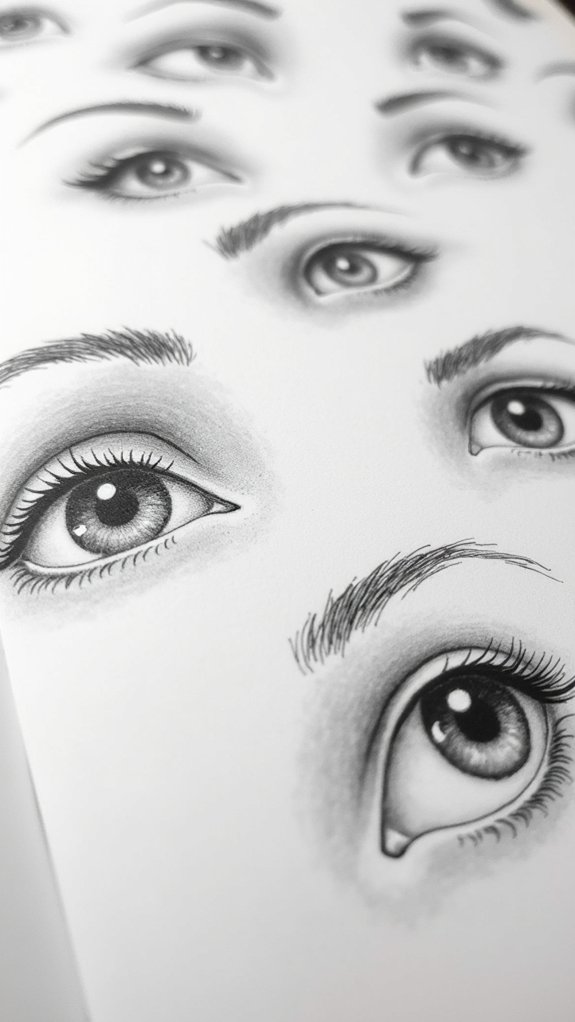
When it comes to making eyes look truly alive, blending eyebrow and eyelid movements is where the magic happens. Eyebrow synchronization with eyelid expressions creates all sorts of emotional dynamics—like how wide-eyed surprise comes with raised brows, or how anger shows up with furrowed eyebrows and heavy lids.
Drawing these features together adds energy and believability, not just stiff cartoon faces. Try watching your own face in the mirror. Notice how your eyebrows and eyelids team up for every emotion, whether it’s excitement, suspicion, or boredom.
Don’t be afraid to exaggerate their movement, especially for cartoon sketches—it can help emotions practically leap off the page!
- Noticing small eyelid twitches that show doubt or anxiety
- Laughing at your own exaggerated surprised face in the mirror
- Capturing the wild rollercoaster of emotions by blending features
Shading to Show Depth and Emotion
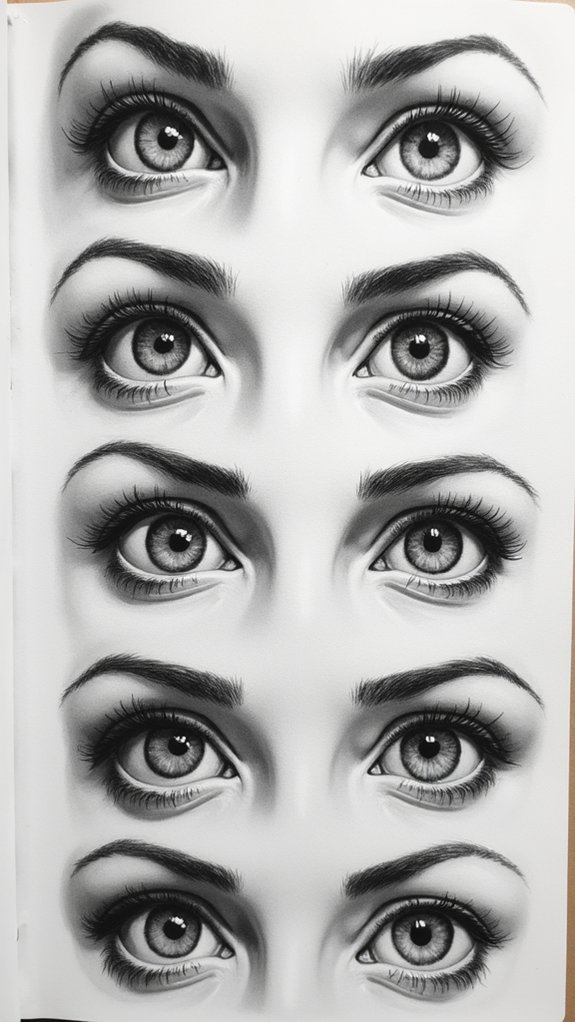
Now that eyebrows and eyelids are working together like the world’s tiniest actors, it’s time to give those eyes some real depth with shading.
Shading isn’t just about making things look 3D—it’s the secret weapon for mood. Using gradients and sharp darks, artists play with eye texture techniques, tapping into emotional color palettes to show everything from sleepy frustration to wide-eyed excitement.
Think about how a strong light source effects the way shadows fall: a shadow under the upper lid can turn a cheerful gaze a little mysterious, or totally worn-out.
Don’t forget highlights—they’re like tiny spotlights for tear ducts or the curve of an iris, making emotion pop. Softer shading says “calm and cozy,” while harsh contrasts scream tension or anger.
Observing Real Gaze in a Mirror for Reference
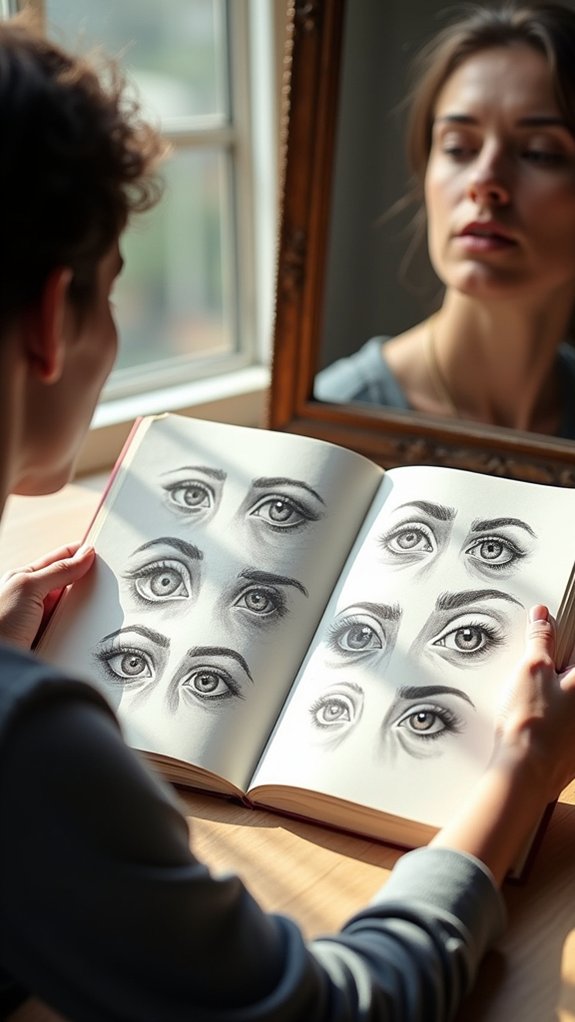
Mirrors might just be the cheapest magic tool in an artist’s toolkit. With a simple glance, they offer instant access to real-life emotional expressions and subtle eye movements.
By watching their own mirror reflections, artists notice how eyelids part in surprise or squint with suspicion. The way their gaze direction darts up in thought, glances sideways in doubt, or fixes straight ahead with confidence becomes a map for drawing believable eyes.
Experimenting in front of a larger mirror, they can see not just their eyes, but also the teamwork between brows and lids. Exaggerating these motions adds extra drama—sometimes, yes, even cartoon-worthy! With every new expression, the mirror brings character sketches to life.
- Eyes glimmer with secret hope.
- Brows arch in exuberant surprise.
- Gaze slides away in silent shyness.
Frequently Asked Questions
How to Make Expressive Eyes?
To make eyes expressive, artists should explore eye shape variations, utilize strategic color impact, and observe real emotions. Adjusting eyebrows and pupil details enhances the emotional connection, bringing greater believability and personality to their character designs.
How to Have Expressive Eyes Naturally?
To achieve natural eye expressions, one should observe facial changes during varied emotions, refine eye movement techniques, and study emotional eye connection. Regularly using these approaches deepens authenticity, allowing one’s gaze to reflect genuine feelings and nuanced emotions.
What Does It Mean if Your Eyes Are Expressive?
When someone’s eyes are described as expressive, it means their gaze conveys strong emotions and thoughts, allowing for effective eye communication, fostering emotional connection, and enhancing visual storytelling without reliance on spoken words or explicit cues.
How Do You Train Your Artistic Eyes?
Training artistic eyes involves refining artistic perception through frequent visual observation and practice. Artists study eye anatomy, analyze emotional nuances in real-life or references, and experiment with varied shapes, gradually internalizing complexities to enhance expressive accuracy and depiction.
Conclusion
After practicing these 13 sketchbook eyes, anyone can see how expressive eyes can totally change a character’s mood. From friendly and wide to angry or suspicious, these eyes have a life of their own—sometimes they look like they’re up to something! Keep messing around with different shapes, shading, and wild eyebrow moves. Every sketch brings a new expression, and who knows? Your next set of eyes might just stare back from your sketchbook and surprise you!

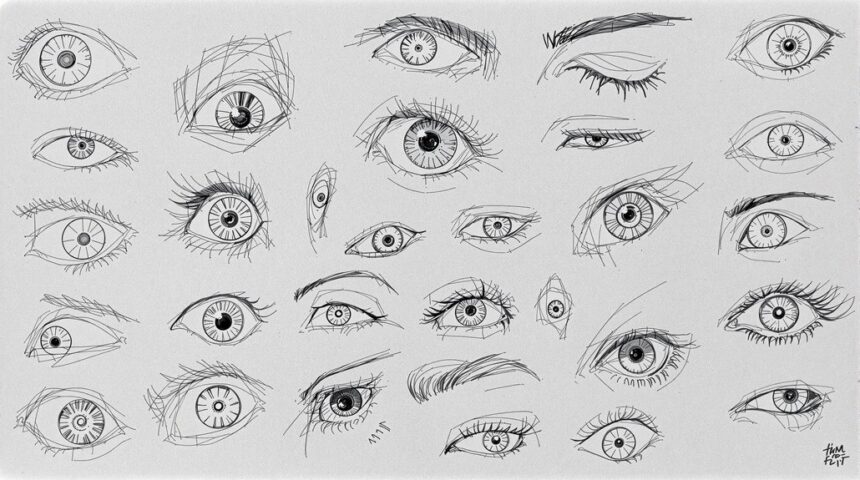
Leave a Reply